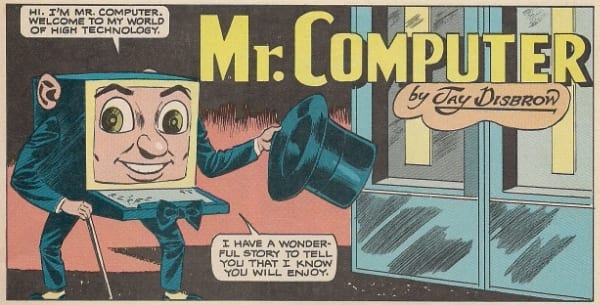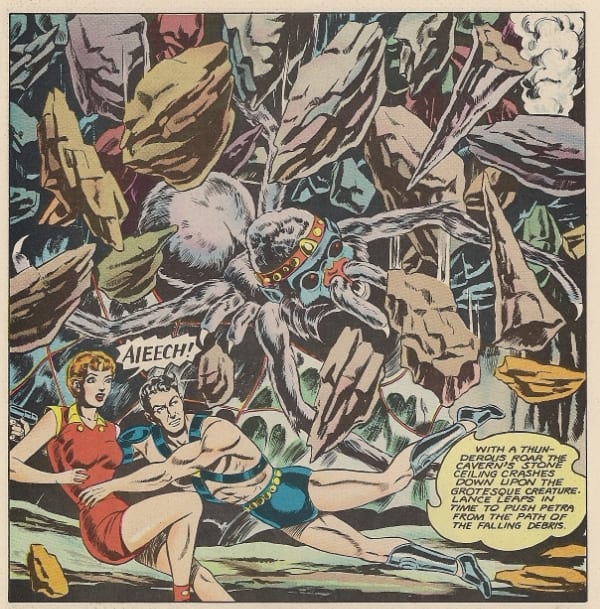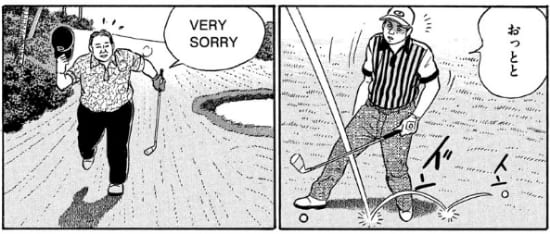"For some reason this became a 'classic,'" Jay Disbrow writes in Alter Ego #117. "Ultimate Destiny" first appeared in Crime Detector #5, a Timor Publications release of July, 1954. "It was the story of a man who turned into a huge blob of protoplasm."
What you see above is the last comic book work of Disbrow's in print: "Alien Operation," from 1990's Aida-Zee #1, the first and only issue of a 'mature readers' Christian comics anthology edited and published by longtime kids' comics veteran Nate Butler. Disbrow is the inker, letterer and colorist, working with penciller Steve Lightle (the original artist for DC's '87 Doom Patrol revival, succeeded by Erik Larsen) and writers Judi Ellingson & Butler. Ellingston was a newspaper editor, with no other comic book credits of which I'm aware, and the whole project seems in retrospect to function as an opportunity for comics-interested parties of little practical experience to ride alongside veterans of various stripe. The story sees alien clinicians kidnapping adult Earthlings at the behest of their parents and performing very late-term abortions. It is not the most intellectually vice-tight contribution to that enduring American debate, but "blob[s] of protoplasm" nonetheless keenly figure into this closing act, wherein Disbrow, 64, still shows some faculty with the grotesque.
"I wasn't really interested in turning out horror stories," the artist told Ray Zone in a 1981 interview also printed in Alter Ego #117. "That was the stuff Leonard [Cole, editor at Star Publications] wanted. He said, 'This is the stuff that's selling and this is what we have to produce.' But I wanted to do science-fiction stories. Once in a while I was able to get one in."
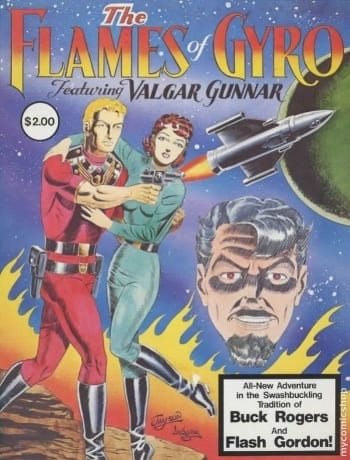 Needless to say, the Jay Disbrow comic most pertinent to this column is 1979's The Flames of Gyro, a historic work not for its content but due to its positioning: it was the first all-original, full-length comic book published by the nascent Fantagraphics Press, until then notable mainly for its acquisition and recalibration of The Nostalgia Journal, a fanzine soon to undergo a title change.
Needless to say, the Jay Disbrow comic most pertinent to this column is 1979's The Flames of Gyro, a historic work not for its content but due to its positioning: it was the first all-original, full-length comic book published by the nascent Fantagraphics Press, until then notable mainly for its acquisition and recalibration of The Nostalgia Journal, a fanzine soon to undergo a title change.
Disbrow too was marginal. As with not a few artists, his career had been wiped out by the adoption of the Comics Code late in 1954; in fact, save for a small handful of romance stories with the Farrell Comic Group and an obscure two-color religious magazine in '57 (Zondervan Publishing's The Centurion of Ancient Rome), he had not published any sequential art since. However, as he told Zone, "[w]hen Gary Groth... offered me complete editorial freedom on the comic, I decided to go ahead with it."
Truth be told, The Flames of Gyro is not all that well-regarded a comic, to the extent that it is even remembered. Following Raymondesque space hero Valgar Gunnar as he casts the tzatziki of justice onto the pork strips of tyranny, Gyro constitutes an extremely old-fashioned, text-heavy homage to classic adventure strips, lacking in both the comparatively lively qualities of contemporaneous genre fare like Sabre -- not exactly an underwritten piece itself -- and the masterful craft of the great strip artists. Disbrow's art, in contrast -- prone to a certain stiffness in even the best of circumstances -- quite resembles the output of a man who'd long ago turned to technical illustration, and it's little surprise the work lingers consciously today primarily as a nugget of trivia.
And yet, this was the dream. Both that of Fantagraphics -- which aspired to raise comics away from the low boundaries of "the stuff that's selling" and up toward the realm of art, which, as a necessary first step, demands at least the potential for the artist's disregard of populist salesmanship -- and the infant Direct Market of comic book retailers, which sought to bypass the vagaries of the newsstand distribution model and offer focused reading experiences for connoisseurs in addition to a reliable stream of superhero product. In those days, I'm told you really could walk into a comic book store and expect to find everything that was available. Jay Disbrow always wanted to draw science-fiction comics, and suddenly - he could. Suddenly, he could write a 100-page biographical profile of Jerry Iger, in whose shop he'd cut his teeth in the early '50s, and Blackthorne Publishing would release it in 1985 as The Iger Comics Kingdom.
Suddenly, comics could coincide again with the daily experience.
I love Mr. Computer! He is dapper as fuck, and an excellent cosplay opportunity. Moreover, there's this sinister edge to him that suggests somebody scooped up the luckless protagonist of "Ultimate Destiny" and poured him into a most hi-tech of utilitarian molds. He's the 'host' of sorts -- a veritable crypt keeper -- for 1986's Captain Electron, a promotional tie-in comic Disbrow wrote and drew for the Brick Computer Science Institute of Brick, NJ, where he worked as a lecturer and eventual public relations director per Alter Ego (itself citing the Who's Who of American Comic Books).
Inside, there's many treats: a comics-format history of computer engineering; a guided tour of computer vocations; a surprisingly dense glossary of computer terms; and, as the book's centerpiece, Disbrow's one and only superhero comic - a 17-page color opus set in and around the school's actual campus, involving the kidnapping of Brick's actual president, Edward Zapp(!), whose comp sci skills are in hot demand by goons eager to dig up a stockpile of plutonium stashed away in the South Jersey Pine Barrens. Only the faculty and student body of the Brick Computer Science Institute can save the day, with a little help from the inexplicable, invincible, tenuously computer-related Captain Electron!
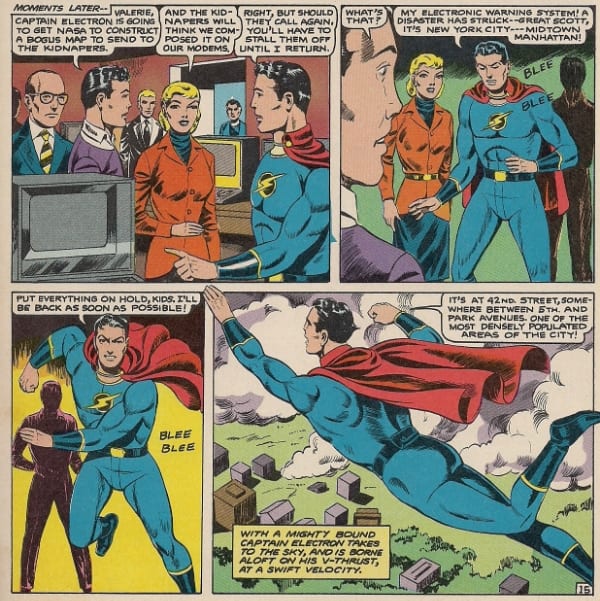
This is so much fun, and not just because of the eccentricities central to Disbrow's style (like Steve Ditko, he's disinterested in depicting modern dress, even in a nominally contemporary story, although my personal theory is that Valerie is a hardcore David Lynch fangirl, up to her fifth theatrical viewing of Blue Velvet, and all the boys on campus are trying to sartorially impress her, because who wouldn't); there's a tremendous sense of play at hand, an enthusiasm for local comics that drives a man toward writing his friends and co-workers and the very roads he drives on into his story. Ray Zone relates that in the eighth edition of The Overstreet Comic Book Price Guide, Disbrow describes himself as prone to "a mania for adventure comic expression" since early childhood - comic book plots "bred within the very fiber of my being... struggl[ing] incessantly to get out of my psyche and into print."
This is the testimony of the fan-addict: the ideal consumer and producer for the early Direct Market, given to brief bursts of opportunity for the weird and determined.
In 1983, Disbrow enjoyed three issues' worth of his very own Neat Stuff, his Eightball, his ACME Novelty Library: Quest Publications' Quest Presents. The Alter Ego checklist suggests that Quest may also have been a division of the Brick Computer Science Institute, but I'm not convinced; the legal address of Quest was in West Hartford, CT, as opposed to Brick, NJ, and its publisher is identified as one Steven Stern (presumably not the Stephen L. Stern who wrote Zen Intergalactic Ninja). Mike DeCarlo contributes some backup stories, but it is absolutely the Jay Disbrow show, matching up the continuing adventures of Lance Carrigan of the Galactic Legion (another Flash Gordon type) with an occasional old-fashioned genre short, like a sci-fi twist story where bold astronauts land on a strange planet and fall prey to calamities, and in the end the commander burns up because he's really on a gigantic contemporary Earth, and he's climbed into a suburban man's pipe, and then the man comments on how odd the tobacco tastes, because he's been smoking people.
Issue #3 is the best, because it's the only one in full color, and Disbrow's coloring is really quite good. Beyond the potential for Christian vocation, however, I suspect he's not interested in applying those skills to comics work by others; he seems a born-determined auteur, the type who, at the age of 73, would suddenly embrace the computerized potential of webcomics and bang out 312 weeks' worth of Sunday-style color adventure strips. It was called Aroc of Zenith, and for over half a decade it endured quietly, away from the din of a troubled Direct Market resuscitating itself from a 1990s near-collapse, from where the now-established likes of Fantagraphics, having propagated the notion of comics-as-art, had withdrawn a ways to eye the bookshelves of America. As Valgar Gunnar taught us, you don't need to put up with industrial shit all the time.
Because even in '83, on the inside back cover of Quest Presents #3, the future was calling.

***
PLEASE NOTE: What follows is not a series of capsule reviews but an annotated selection of items listed by Diamond Comic Distributors for release to comic book retailers in North America on the particular Wednesday, or, in the event of a holiday or occurrence necessitating the close of UPS in a manner that would impact deliveries, Thursday, identified in the column title above. Not every listed item will necessarily arrive at every comic book retailer, in that some items may be delayed and ordered quantities will vary. I have in all likelihood not read any of the comics listed below, in that they are not yet released as of the writing of this column, nor will I necessarily read or purchase every item identified; THIS WEEK IN COMICS! reflects only what I find to be potentially interesting.
***
SPOTLIGHT PICKS!
Atomcat: In all candor, this is not the best Osamu Tezuka manga available. It's C-level work, a 1986-87 kids' series in which Tezuka revisits his Astro Boy (i.e. "Mighty Atom") series by way of [A] tomcat (get it?) who finds his mangy feline ass upgraded by space aliens who cannot distinguish comics from reality into a kitty replica of the popular bullet-shitting hero. Naturally, he comes to the frequent aid of a nerdy manga-reading local boy, whom Tezuka amusingly refuses to develop anywhere beyond risible inefficacy at any given challenge. Still, lesser Tezuka is like lesser Carl Barks: still pretty fun, still well-made, still occasionally interesting (there's this subtle running theme of contemporary life proving unable to match the triumphs of the past, which strikes me as heavy self-deprecation on the author's part), and probably much less likely to remain in print for long, especially given the Kickstarted origins of this 200-page DMP edition; $12.95.
A Distant Soil #40: God damn, now *that* is manga influence! Colleen Doran was getting shit done circa Quest Presents, though, and now her signature SF series A Distant Soil continues at Image, boasting the kind of wavy psionic combat long ago departed from any widespread publication of Japanese comics in English. Check it out, you might enjoy the sensation. Preview; $3.50.
--
PLUS!
Rogue Trooper Digest Vol. 1: Welcome to Nu-Earth: This appears to be a companion series to Rebellion's line of 5" x 7.75" Judge Dredd digest softcovers, here presenting 160 pages of Gerry Finley-Day future war stuff from the early '80s. There's a good deal of Dave Gibbons art in here for thrifty browsers, hopefully retaining some legibility at this size; $11.00.
The True Lives of the Fabulous Killjoys #1 (of 6): Many of you will recall The Umbrella Academy, a pair of *very* strongly Grant Morrison-inflected Dark Horse series that ran from 2007 through 2009 - they were fun little mainstream-y superhero-ish comics, and, as such, briefly attracted an enormous amount of praise and fascination centered on writer/creator Gerard Way of the musical outfit My Chemical Romance. This new Dark Horse miniseries marks Way's return to comics, co-writer Shaun Simon in tow, for a tie-in to a 2010 MCR album, illustrated by the always-adept Becky Cloonan. Preview; $3.99.
Superman Unchained #1: Having no doubt puzzled out through sheer force of continued frustration that superhero comics need to be really, really focused in order to benefit from a major motion picture, DC now presents a huge-ass A-list Superman series to tie in with this weekend's Zack Snyder affair. Scott "No Relation" Snyder (pretty much the only new 'superstar'-level genre writer to emerge in years and years) teams up with Jim Lee for this guaranteed cash cow, which will presumably double as an instant line-leader for the otherwise floundering red 'n blue wing of the company. Also available in a "Director's Cut" edition with no inks or colors, and Snyder's complete script included as an extra. Plus: the obligatory eight or nine variant covers. Preview; $4.99.
American Vampire: The Long Road To Hell: That said, Snyder (a sturdy, efficient craftsman with a flair for gross-out punch) does exhibit an endearing determination to keep DC's malnourished Vertigo division up and walking through new projects like The Wake, as well as this 64-page one-off revival of the horror series that first brought him to wide attention, drawn by Rafael Albuquerque in anticipation of a formal relaunch later this year. Preview; $6.99.
A1 #1 (of 6): Being a new Titan Comics revival of the often-excellent late '80s/early '90s anything-goes Britcomics anthology as what looks to be a forum for new genre work, primarily written at the moment by original series co-editor Dave Elliott. A very diverse international cast of artists is involved, presumably as sampled in recent issues of Heavy Metal; $3.99.
The Simon and Kirby Library - Science Fiction: Yeah, comic book science fiction - influential, if we're talking about seizing the minds of '50s youth, but never as sturdy a seller as crime, horror and romance, and never quite as obsession-building as superheroes. No doubt seeking redress for this historical inequity, Titan Books is now *totally* releasing the SF tome of their Joe Simon/Jack Kirby archives before the horror volume, and OMG I am shaking! Expect 352 pages of collaborative speculation in the form of lots of issues of Blue Bolt and various other projects. Samples (not big on that coloring); $49.95.
Creepy Archives Vol. 16: Aw, here's some horror comics. It ain't so bad. From Dark Horse, as usual, collecting issues #73-77 of the original Warren magazines, featuring art by Richard Corben, Alex Toth, José Ortiz, Rich Buckler & Wally Wood, John Severin, Paul Neary, Esteban Maroto, Vicente Alcazar and Neal Adams with the classic, Jim Stenstrum-scripted sniper-on-the-roof story Thrillkill. Great batch this time; $49.99.
Harold Gray's Little Orphan Annie Vol. 9: Saints and Cynics: Plunging into the 1940s with 296 pages of vintage spunk & spit, and -- if the cover art I've seen is correct -- a supplement by Journal contributor and Canadian patriot Jeet Heer; $49.99.
Knights Of Sidonia Vol. 3: I wonder if Kodansha's sales of Attack on Titan (vol. 5 is out this week) saw a jump due to its enormously popular anime adaptation? North American anime fans are pretty notorious for never spending money on anything, though, so I wonder I this kind of thing serves as an awful parody of superhero comics' comprehensive failure to capitalize on the genre's towering public visibility? Nonetheless, Knights Of Sidonia -- Tsutomu Nihei's excellent, elliptic homage to space-faring anime of the 1980s -- will also soon be a talkie cartoon, and Vertical remains your source for keeping abreast of the source material; $12.95.
The Walking Dead #111: Speaking of adaptations, this weekend I played a little bit of Telltale Games' The Walking Dead video game. It's a big hit, which shouldn't come as much surprise, since The Walking Dead is a gigantic (popular, financial) success in almost every form it takes, but the video game is also a pretty enormous *critical* success amongst gaming journalists and devotee writers, which is a new thing for the franchise: being thought of as 'at the forefront of the art,' let's say. Basically, it's an interactive movie/television show along the lines of 2010's supremely goofy-looking but apparently well-regarded Heavy Rain (I've not played it), in which the player is made to survive the zombie apocalypse less by clicking an axe onto individual zombies' heads than by making responses to other non-zombie characters' requests within very brief time limits. Sometimes, the choices you make result in a supporting character's death, or causing a character to lose trust in you, and when that happens the character is absent/distrustful for however much you have left of the game's five episodes (which were initially released as a serial, although they're all packaged together now).
It's a well-acted thing, pretty nice-looking. The storytelling is shamelessly manipulative and prone to hackneyed bouts of metaphor -- basically, your (male-only) character develops a father/daughter relationship with a poor little girl who's lost her parents and YOU, IT TURNS OUT, RUINED YOUR OWN FAMILY IN A FIT OF VIOLENCE, and oh, the pathos! -- but the atmospherics and general tone of stopwatch desperation really do plop you right into the middle of a survival horror situation in a uniquely effective manner; I can't remember any other game that's made me so reluctant to talk to other characters, out of concern they'd start interrogating me over my life choices. Basically, it's a great way to have a panic attack playing video games.
Anyway, what I found particularly interesting is that at the end of the every episode, the game gives you a set of live stats revealing how players in aggregate responded to certain choices. Most of the stats in Episode 1, hover around the 40-60 or 50% mark for each option, which makes sense - the episodes only take about two hours to play, so a lot of gamers are probably going back and selecting alternate choices to see what happens, thus leveling out the totals. There is one exception, though. Near the end of Episode 1, you are given the choice of running to the aid of either a good-looking woman or a doughy guy. Moreover, the woman is carrying a weapon, and, for the lizard-brained among us, is aware of certain incriminating facts about your character's background that might prove deleterious later. The doughy guy, meanwhile, is totally helpless, and utterly trusting of you. Yet, even accounting for the very likely possibility that players are choosing 'both' paths at different times, the vast majority elect to go aid the woman.
Have traditional gender roles become so ingrained in gaming that a man hustling to the rescue of a woman is immediately perceived as an inevitable necessity? Is there some easter egg involved or a meme at work that's skewing the results? Or do players just not want to risk looking at some fat guy for eight more hours if given an alternate? All I know is that he seemed like a good dude, and I swear to god I thought that lady's gun was still loaded. Also: The Walking Dead is still a comic book, and here is the newest issue; $2.99.
Machine Sabbath: And we'll round out the week with a comics offshoot of a different kind - a 48-page IDW hardcover catalog of sorts for a recent Ashley Wood exhibition at the Jonathan LeVine Gallery in NYC. All those present for Ghost Rider 2099 may nod solemnly now; $17.99.
--
CONFLICT OF INTEREST RESERVOIR: Possibly the absolute best of Anders Nilsen's work sees an expansion this week, as the end -- formerly an oversized comics magazine -- transforms into an 80-page, 7.25" x 10.5" hardcover, presenting the process of deep grief as a system of sequential image routines, as if the very character of the comics form has become saturated with ill capacity, though from there it might posit a means of reconfiguring an upset life; $19.99. Meanwhile, since so much of the comics industry views success in movie terms, I can only assume that Cathy Malkasian -- co-director of 2002's $60 million-grossing The Wild Thornberrys Movie -- is among the biggest names in the art form today, and now she's brought 192 pages of Wake Up, Percy Gloom!, a follow-up to her 2007 allegory of misplaced faith from the same publisher as The Flames of Gyro, burning still; $28.99.
--
Thanks so much for reading this column. Do enjoy your President Shima Kōsaku diptych of the week:




